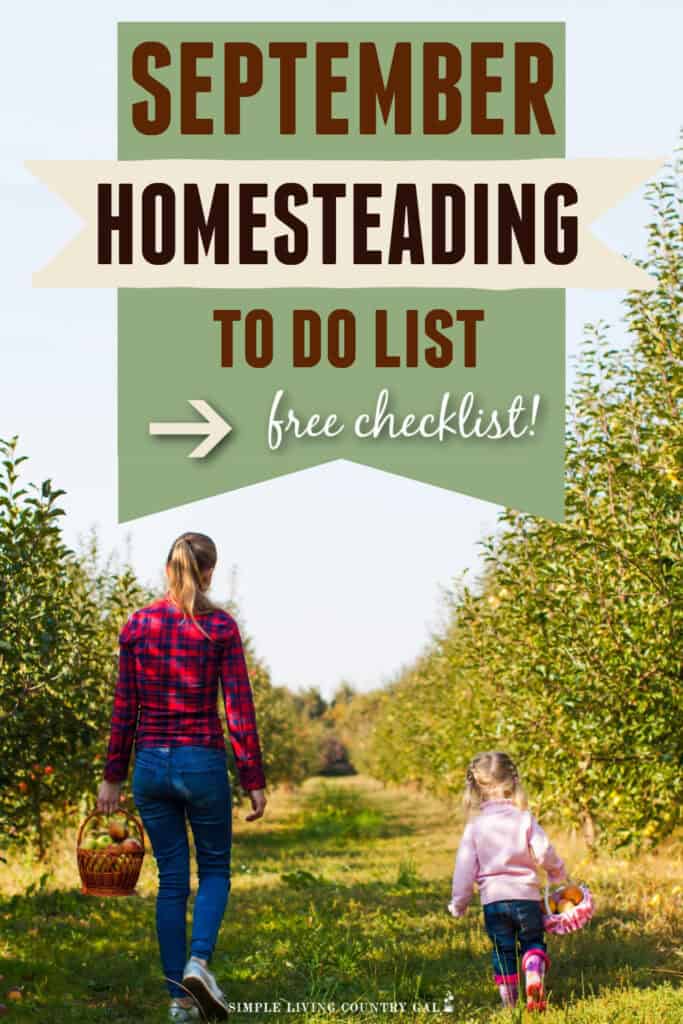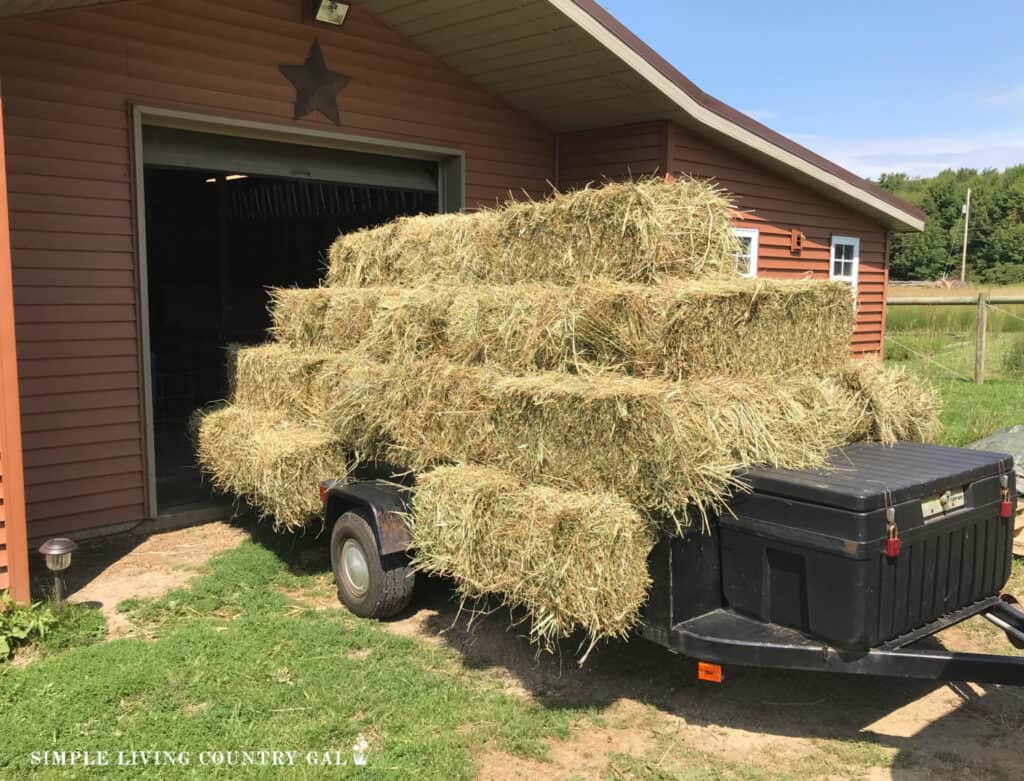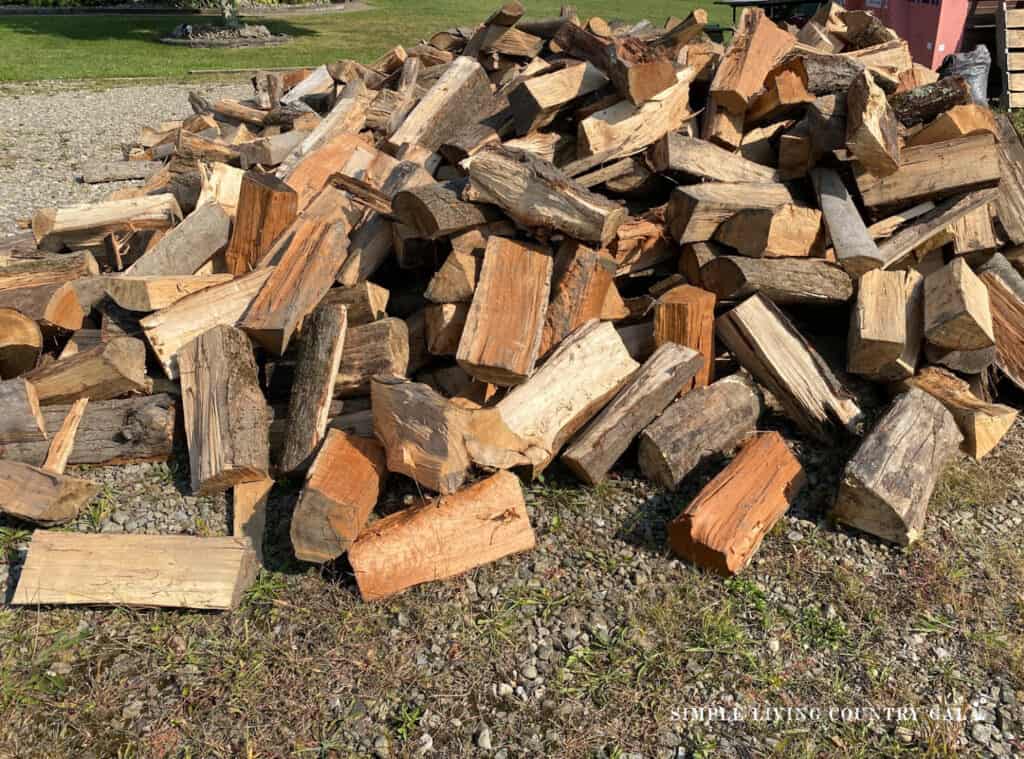September homesteading to-do list
Welcome to the September homesteading to-do list, the easier way to ensure all the things are getting done on time this month. This quick guide will get you on track with your garden, livestock, homestead, and more.
Keep this September list with all your homesteading tips so you can refer each year, ensuring you stay on top of everything that needs your attention and care in August.

September is the start of fall and that means busy season is officially here. Where we live, winter is a big deal and it takes a few months to get everything and everyone ready.
From our coop and barn to our own home there are a few routine tasks that need attention to help ensure we handle the cold and wet weather just as well as we are ablew.
what should you work on in september on a homestead?
When a new month begins, the first things I look at are our garden and livestock. These two areas rely on us to keep them warm, dry, and protected. Giving them my top attention will ensure they do well and thrive even while the weather begins to deteriorate.
September Homesteading To-do list
This list is similar to our other monthly homesteading lists as it is broken down into different areas. You can jump around as needed and work your way through prepping your homestead for fall.
Be sure to grab the FREE September Homesteading to-do list below to ensure you stay on track!
Garden Tasks for september
Harvesting should be winding down this month as the days get shorter and the weather gets cooler. The main goal this month is closing out the areas that are finished growing.
#1. Replenish Mulch
Add fresh mulch to any plants that will continue to grow in the fall. This will help to stop weed growth and keep the plant insulated.
- Lettuce
- Radishes
- Spinach
- Carrot
- Kale
- Broccoli and cauliflower
#2. PUll done plants
Pull out any plants that are finished growing. Look for dead leaves, plants, and no fruit growth. Be sure to pull the entire plant out along with any roots if possible.
Good Healthy Growth
If you plant was healthy throughout the growing season, you can put it into your compost area. Be sure to remove any seeds first and to cut the plant up into smaller pieces.
Pest or Disease Growth
If your plants have any issues, do not put them into your compost area. The best disposal is an area in the corner of your property away from where you garden or compost. This will help to prevent issues from carrying over year after year.
#3. Plant garlic
September through October is a good time to plant your garlic. This will give the roots time to take hold before they hibernate for the winter.
Come spring, shoots will emerge from the ground and continue to grow until harvest time in July/August.
Get our complete guide: How to Grow Garlic Step by Step
#4. Fall Garden clean up
Closing up the garden for fall is an important step to ensure you have healthy soil for planting in the spring.
- Remove any weeds, plants, or rocks.
- Use a tiller to break up the soil.
- Rake out any debris you may have uncovered.
- Test the soil to see where you are at now.
- Amend the soil depending on what your test shows.
Get our FREE Cleaning Up the Garden Checklist to add to your binder.
#5. Water
If you are done with your garden for the year, water area.
- Be sure to remove any water from your hose, roll it up, and secure it with a tie or string.
- Store in a barn of shed until spring.
- Turn off the water to the faucet.
- If you use a rain barrel, dump it, dry it, and store it away until spring.
Livestock Tasks for September
Livestock task for this month centers around prepping and preparing for the colder months. If you butcher livestock this will be on your list as well.
#1. Hay
If you do not grow hay, start looking now to purchase your second crop stock. Have an area in your barn to store enough hay to get you through until spring if you are able.
Be sure there is plenty of airflow to keep the hay from getting wet and moldy. We like to stack our hay bales on pallets to keep them up off the floor. This helps to keep the bales dry throughout the winter months.

#2. Meat Production
Cows and pigs are commonly butchered in September-December. If you raise livestock for meat, make an appointment now with the local butcher to take your animals in. Things can get booked up quickly this time of year so get your spot now so you do not have to way too long or be forced to go in to early.
If you want to purchase farm-raised meat, you can call your local butcher or a farmer nearby who raises livestock. Many times you can buy meat by the pound, in whole, or by the side.
#3. Breeding
September is still early in the breeding season, but if you breed for 4H you will want to time things out appropriately.
Be sure you have things prepped before starting:
- Remove any livestock you do not want to be bred. Find a temporary area to house them until you are finished breeding.
- Start records for each female you plan to breed so you know the target due date.
- Chose your breeding male either from your herd or look into hiring one temporarily for the season.
- Choose the breeding method you plan to use and keep notes on how things progress. This will help you narrow down a good routine your homestead can stick with.
Chicken Tasks for September
Fall is a big adjustment for the coop and this list will help you to stay on top of things.
#1. Molting
Watch your flock for signs of molting and support them as needed.
- Give them a safe space to stay until they are done to prevent flock aggression.
- Watch for signs of stress.
- Increase feed during molt and give high protein treats.
#2. Run Upkeep
Fall is usually much wetter than other months and that can really affect the quality of your run. area.
- Add a tarp overhang to help keep some of the rain out.
- Add a layer of sawdust or wood shavings for a dryer surface to walk on.
- Add a few logs that your hens can stand on that is up and out of the mud.
#3. Coop Cleaning
If you did not clean the coop in August, now is the time to get that project done.
- Remove everything inside so you can sweep it out from ceiling to floor removing all cobwebs, dirt, and dust.
- Wash what you can remove, such as the feeder, waterer, and nesting boxes.
- Scrape any debris from the roost and other areas.
- Close up any holes where mice or other rodents can get inside.
- Fill nesting boxes with clean fresh straw.
- Fill and return the waterer and feeder.
- Put in a layer of fresh bedding on the floor.
#4. Inspect for holes or cracks
The biggest issue with a coop in the winter is predators and rodents getting inside. While you are cleaning, be sure to inspect the entire coop and look for any openings. Close them up with boards to keep pests out and away from your flock and eggs.
Barn Tasks for September
If you have a barn, there are things you can do to get it ready for the cold wet weather.
#1. Clean out
Do a barn clean out from ceiling to floor.
- Using a broom or shop vac, sweep out any cobwebs from the ceiling.
- Do the same to the walls.
- Finish up by sweeping the entire floor area.
- Clean any windows and door jams.
#2. Upkeep
Take time now to do a walk inspection both inside and outside of your barn. Look for any issues that may not make it through the winter and fix them now. inside and outside
Homestead Tasks for September
Last is the home and homestead and inspection is the buz, and inspection is the buzzz word for both of these areas.
#1. Fence
If you use temporary fencing that cannot be up throughout the winter, plan now when you will want to remove and store it. Get it on your project calendar, so you remember to get it done.
We use electric fence woven netting and prefer to take it down in the fall to ensure it stays in good shape. This is usually done the end of September to October.
Premier 1 Electric Goat & Sheep Net Fence | Yellow – 42

#2. Walk the rest of the fence
Walk any fence that is permanent and look for things that need to be fixed.
- Broken wire
- Shredded tape
- Cut fence
- Rotted posts
#3. Heat
If you use a material to heat your home with and haven’t ordered yet, do so now. Look at past seasons to ensure you order enough now when the price is lower.

#4. Records
One of the most important parts of a homestead is keeping notes throughout the year. This will help you to improve as you go along learning from any mistakes or issues that you may have gone through.
Set up a binder to keep notes and checklists for the summer. Be sure to keep this binder where you can refer to it this winter as you plan for the following year.
Keeping up with each area of a homestead can seem overwhelming, but all you need is a checklist for each month. This will not only make it easier to be productive but also help you tackle specific projects that need your attention each month.
Keep this September Homesteading To-Do List in your binder along with any of our other monthly lists for the entire year.



